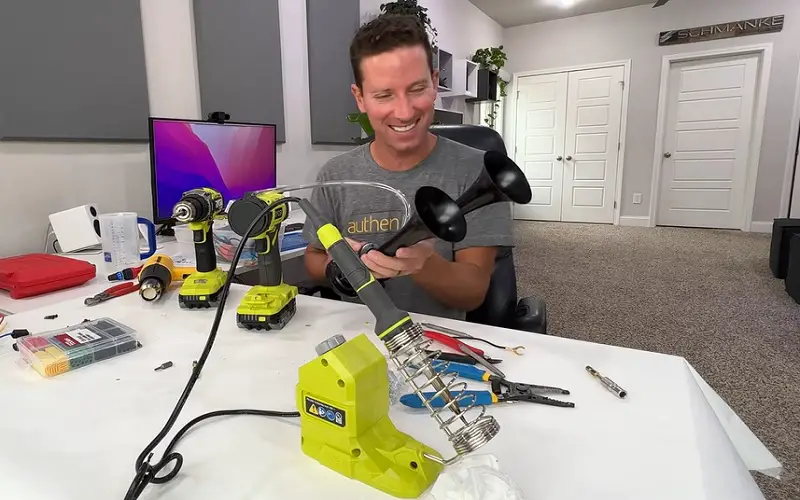To make a Dewalt train horn, gather Dewalt air compressor, train horn kit, and necessary tools. Install components following instructions provided.
Building your own Dewalt train horn can add a unique and functional feature to your vehicle. The loud blast of a train horn can be a fun addition, ideal for catching attention or signaling in emergencies.
By carefully assembling the Dewalt air compressor and train horn kit, you can create a powerful and quality horn system.
With the right tools and precise installation, you can enjoy the benefits of a custom Dewalt train horn for enhanced safety and amusement while driving.

Contents
Gathering Materials
Before diving into the process of making a Dewalt train horn, the first step is to gather all the necessary materials and tools.
Selecting the right Dewalt tools and choosing the ideal horn components is crucial in ensuring the successful construction of the train horn. Let’s take a closer look at what you’ll need for this DIY project.
Selecting The Right Dewalt Tools
When it comes to selecting the right tools from Dewalt, it’s essential to ensure you have the necessary equipment for the project. Here’s a list of some recommended Dewalt tools:
- Dewalt drill
- Dewalt impact driver
- Dewalt circular saw
- Dewalt angle grinder
- Dewalt jigsaw
Choosing The Ideal Horn Components
Choosing the ideal horn components is equally important to the success of the project. Here are the essential horn components you will need:
- Train horn kit
- Compressor
- Horn buttons/switches
- Air tank
- Air hose and fittings
Understanding The Basics
A train horn operates on compressed air to produce a loud, distinctive sound.
The air pressure travels through the horn’s chambers, causing the diaphragm to vibrate.
This vibration creates sound waves that amplify and emerge as a powerful train-like horn blast.
- Wear appropriate protective gear, including goggles and gloves, when working with tools.
- Ensure proper ventilation in the workspace to avoid inhaling harmful fumes from materials.
- Exercise caution when handling sharp objects or high-pressure equipment to prevent injury.
- Follow the manufacturer’s guidelines for operating and maintaining tools and equipment.
Assembling The Components
Learn how to make a Dewalt train horn by assembling the components with these simple instructions.
Preparing The Dewalt Tools
Before you begin assembling the components of your Dewalt train horn, it is important to gather all the necessary tools. Having the right tools will make the process much smoother and more efficient. Here are the tools you will need:
- Dewalt reciprocating saw: This powerful saw will be used to cut the necessary holes for the air compressor and horn.
- Dewalt power drill: You will need a drill to create holes for mounting brackets and wiring.
- Dewalt socket set: This set will help you tighten and secure the horn components.
- Pliers: Pliers will come in handy for gripping and manipulating small parts of the horn.
- Electrical tape: You will need electrical tape to insulate and secure any exposed wires.
Connecting The Horn Components
Once you have gathered all the necessary tools, it’s time to start assembling the components of your Dewalt train horn. Follow these steps to ensure a successful connection:
- Step 1: Begin by attaching the air compressor to the mounting bracket. Secure it with a bolt and washer using your Dewalt socket set.
- Step 2: Next, mount the air compressor to a suitable location on your vehicle. Make sure it is positioned securely and won’t interfere with any other components.
- Step 3: Connect the air compressor to the horn using the provided air hose. Cut the hose to the desired length using your Dewalt reciprocating saw, if necessary.
- Step 4: Use the pliers to clamp the air hose onto the connectors of both the air compressor and the horn. Ensure a tight and secure connection.
- Step 5: Once the horn is connected to the air compressor, it’s time to wire it to a switch inside your vehicle. Use your Dewalt power drill to create a hole for the wire to pass through.
- Step 6: Run the wire from the horn to the switch, making sure to keep it away from any hot or moving parts of the vehicle.
- Step 7: Strip the ends of the wire and attach them to the appropriate terminals on the switch. Secure the connections with electrical tape for added insulation.
- Step 8: Finally, test the horn by activating the switch. Listen for a loud and clear sound, indicating a successful connection.
With these simple steps, you can effortlessly assemble the components of your Dewalt train horn. Make sure to follow all safety precautions and double-check your connections before testing the horn. Soon enough, you’ll be enjoying the powerful sound of your DIY train horn wherever you go.

Installing And Testing
Discover how to easily install and test your DIY Dewalt train horn with step-by-step instructions for a seamless setup and evaluation process. Follow these simple guidelines to ensure your Dewalt train horn is functioning at its best.
Installing and Testing Once you have assembled your Dewalt Train Horn, it’s time to install and test it to ensure it functions flawlessly. In this section, we will guide you through the installation process and provide step-by-step instructions on how to test the train horn for proper functionality.
Mounting the Train Horn To begin the installation process, you will need to mount the train horn in a suitable location on your vehicle. Be sure to choose a sturdy and secure spot, such as the undercarriage or the front grille.
Follow these steps to mount the train horn properly:
1. Begin by selecting a location that allows for easy access to the horn and minimizes obstructions. The front grille or under the vehicle are common mounting spots.
2. Use the necessary tools, such as a wrench or screwdriver, to secure the train horn in place. Ensure it is tightly fastened to prevent any vibrations or movement while in use.
3. If needed, refer to your vehicle’s instruction manual for any specific guidelines or precautions related to horn installation. Ensuring Proper Functionality Once the train horn is securely mounted, it’s crucial to ensure its proper functionality before hitting the road.
Follow these steps to ensure your train horn works effectively:
1. Connect the necessary electrical wiring to the train horn according to the manufacturer’s instructions. Take extra care to ensure proper polarity, as incorrect wiring can result in malfunctions or damage.
2. After connecting the wiring, turn on your vehicle’s engine and test the train horn by pressing the horn button. Listen for a loud, distinct train-like sound. If you hear any abnormalities or if the sound is not as expected, double-check the wiring connections and consult the instruction manual for troubleshooting tips.
3. If the train horn is functioning correctly, ensure that it meets any legal requirements or restrictions in your area. Some jurisdictions have noise regulations in place, so be sure to comply with any relevant laws to avoid any potential fines or penalties.
4. Finally, perform a test run by driving your vehicle around to ensure the train horn operates consistently and reliably. Pay attention to any strange noises or possible issues, and make necessary adjustments or repairs as needed.
Remember, safety is of utmost importance when installing and testing your Dewalt Train Horn. Follow all instructions carefully and take necessary precautions to avoid any accidents or injuries.
With proper installation and regular maintenance, your train horn will provide a powerful and attention-grabbing sound for all your signaling needs.
Adding Customization
Learn how to customize your Dewalt train horn to create a personalized sound that matches your style.
With a few simple modifications, you can easily elevate your train horn to stand out from the crowd. Customize your Dewalt train horn to make a unique statement that reflects your individuality.
Add a touch of personality to your Dewalt train horn by customizing it to suit your preferences.
Painting And Finishing Touches
Integration With Existing Systems
Maintenance Tips
As the owner of a Dewalt train horn, it’s essential to understand the importance of maintaining your horn to ensure it continues to function at its best. Regular maintenance can prevent issues and extend the lifespan of your train horn.
In this section, we’ll cover essential maintenance tips for your Dewalt train horn, including cleaning and lubricating, as well as troubleshooting common issues.
Cleaning And Lubricating
Regular cleaning and lubrication are crucial for keeping your Dewalt train horn in top working condition. Here are some simple steps to follow:
- Use a mild detergent and water to clean the exterior of the train horn, then dry it thoroughly with a soft cloth.
- Inspect the horn for any debris or blockages, clearing them carefully to ensure proper air flow.
- Apply a small amount of silicone-based lubricant to the moving parts of the horn, such as the diaphragm and valves, to prevent rust and ensure smooth operation.
Troubleshooting Common Issues
Even with proper maintenance, you may encounter issues with your Dewalt train horn. Here are some common problems and their solutions:
- Weak Sound: Check the air supply to ensure it’s at the correct pressure. Clean and lubricate the diaphragm and valves if necessary.
- Excessive Vibrations: Inspect the mounting hardware and ensure it’s securely fastened. Tighten any loose bolts or screws to reduce vibrations.
- Air Leaks: Test for leaks by spraying soapy water on the connections and listening for bubbles. Tighten any connections that show signs of leakage.
Legal Considerations
When installing a Dewalt train horn, it’s crucial to consider the legal implications and ensure compliance with noise regulations. Understanding the legal framework surrounding noise emissions and obtaining the necessary permits is important to avoid fines and legal repercussions.
Understanding Noise Regulations
Before installing a Dewalt train horn, it’s essential to familiarize yourself with local and state noise regulations. Different regions have specific limits on noise levels, especially in residential areas and public spaces.
Exceeding these limits can result in hefty fines and even legal action. Keeping the noise within permissible levels is not only a legal obligation but also a consideration for maintaining harmonious community relations.
Applying For Necessary Permits
Once you are aware of the noise regulations, it’s important to obtain the required permits. Check with the local authorities or the Department of Transportation to determine the necessary permits for installing and using a train horn.
Applying for permits demonstrates your commitment to adhering to the legal requirements and ensures that you have the necessary authorization to operate the horn within the prescribed limits.

Frequently Asked Questions
Why Are Train Horns Illegal?
Train horns are illegal in certain areas to reduce noise pollution and protect public safety. Restrictions ensure compliance with local noise ordinances and limit disturbances to nearby residents.
Does Dewalt Make An Air Horn?
No, DeWalt does not manufacture air horns. They primarily focus on power tools and equipment.
How Many Psi Does A Train Horn Need?
A train horn typically operates at around 125 PSI to 150 PSI to produce the loud, distinct sound. This high pressure ensures a powerful and audible signal for safety and communication purposes.
How Many Db Is A Freight Train Horn?
A freight train horn typically measures around 110 decibels (dB).
Conclusion
Crafting a Dewalt train horn is a creative and customizable project. By following the steps provided, anyone can create a unique horn for their vehicle.
Embrace the DIY spirit and enjoy the satisfaction of making something truly one-of-a-kind. Get ready to honk in style!

